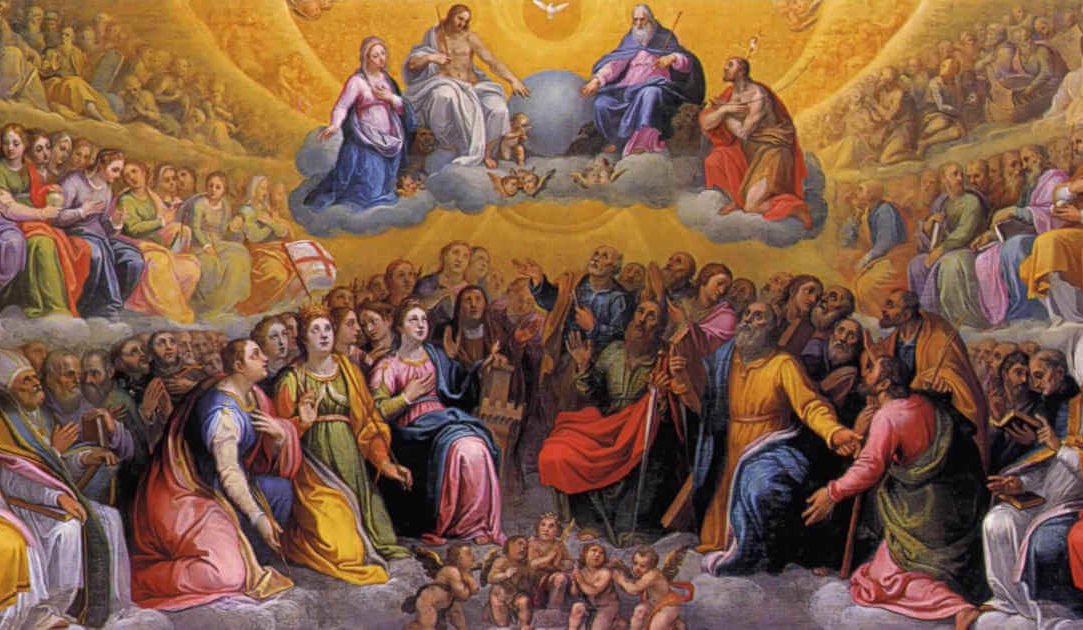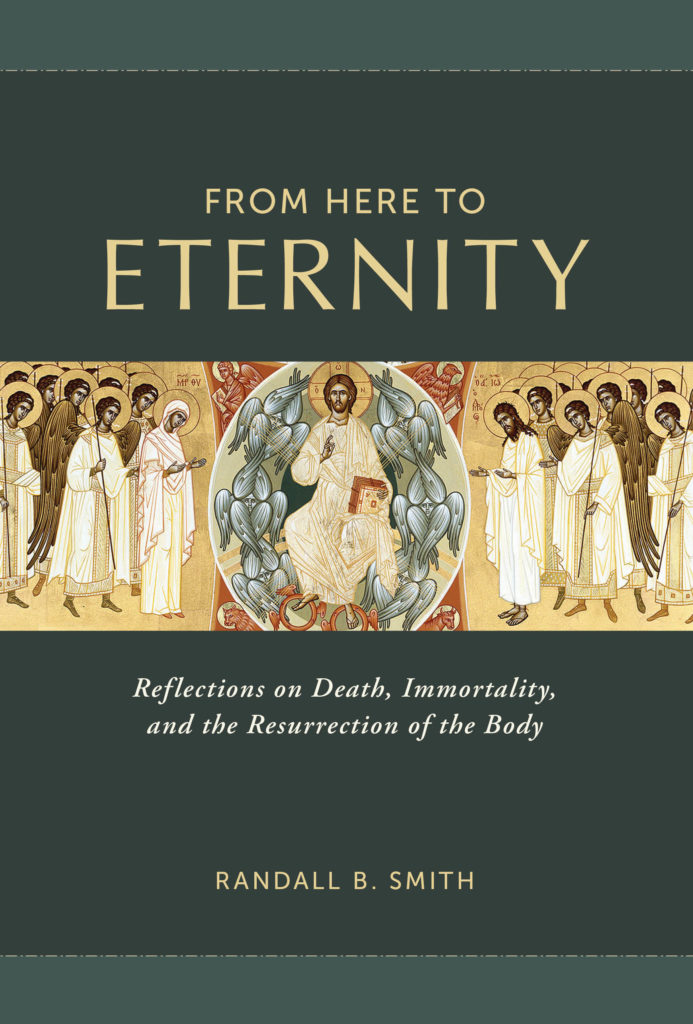
So what sort of hope does the Christian teaching about the resurrection of the body and the communion of saints hold out for us? To answer this question, we must first distinguish between what revelation teaches and what later artistic representations have sometimes led people to imagine. We begin by putting out of our minds pictures of people with halos standing on fluffy clouds. This is not to fault those pictures any more than we would wish to fault Renaissance paintings of the birth of Christ or of the Last Supper even though we know that these paintings idealize the scenes in various ways and are not meant to be taken as if they were snapshots of the original historical event. Artworks of this sort were meant to bring out a certain meaning of the event and to inspire wonder, awe, and ultimately worship. Modern artists, too, are not usually painting as though they were trying to do what we do when we take a simple photograph. Van Gogh did not paint “Starry Night” the way he did because he thought it would do the work a photograph would do. He wanted his viewers to see something new, something beyond the everyday. So, too, when Renaissance and Baroque artists painted saints on the clouds, they wanted people to look up at the clouds they saw above them every day and imagine that they were in the presence of God and the saints.
To be honest, we have very little idea what heaven is like. The most common image we get in the Scriptures is of a heavenly city, built with walls and buildings that gleam like precious stones. This image is meant to signify a reality beyond our comprehension, but what we can discern from this image and from other parts of revelation is that heaven is not a lone existence; it is a communion of persons. This view of the afterlife suggests that we should prepare for death by continually perfecting our ability to enter into a communion of persons with God and with others. This communal understanding of the afterlife is reaffirmed, as we will see, by the Trinitarian character of our union with God, who is both One and Three, and by the doctrine of the communion of the saints. What would entering into this communion of persons entail? Many things, obviously, but among them, the reduction of selfishness and all those dispositions that lead us to sin against others and the development of virtues that perfect our ability to unite with others without losing ourselves in a collectivist mass, such as happened so tragically in the twentieth century with Nazism, Fascism, and Communism.
Speculations about what heaven will be like—whether there will be flowers, dogs, meadows, trees, or ice cream—are probably pointless. We are not told. But we can be certain, in faith, that there is nothing good in this world that could possibly be lacking in God, who is the Source of all Being, Goodness, and Beauty in creation. Whatever there is that is good in flowers, dogs, meadows, trees, and ice cream not only will be present there but will be present even more fully. To experience them in their Source, as contrasted with the way we experience them now, is like the difference between reading a letter from your beloved, which can bring a certain, undeniable joy, and being present with your beloved. We would consider it odd if a person preferred only reading letters and never wished to be present with his or her beloved.
What we call “heaven” is a name Christians give to our union with God after death, when we will enjoy the beatific vision—that is to say, when we will share with God so great an intimacy that itis said we will see God “face to face,” the way lovers stare into each other’s eyes. This fuller union and deeper communion is made possible by our union with the Body of Christ.
Let me suggest, then, that, in addition to the images of the heavenly city we get in the Scriptures, the clearest and most definitive revelation of what “heaven” is has been given to us in the person of the risen Christ. As we have seen, St. Paul describes the proclamation that Christ has risen from the dead as “of first importance.”For him, this is the heart of the good news: that Christ “has indeed been raised from the dead” and is “the first fruits of those who have fallen asleep” (1 Cor 15:20). Hence it is no accident that each of the four Gospels should culminate in the story of Christ’s death and Resurrection. In John’s Gospel, soon after Jesus has washed the disciples’ feet, he says to them: “In my Father’s house are many rooms; if it were not so, would I have told you that I go to prepare a place for you? And when I go and prepare a place for you, I will come again and will take you to myself, that where I am you may be also. And you know the way where I am going” ( John 14:2–4).
From this statement alone, we might imagine that Jesus is saying that he is going to a place and will later show the disciples how to get to that place. The Apostle Thomas shows that this is the way he has interpreted Jesus’s statement when he asks: “Lord, we do not know where you are going; how can we know the way?” (v.5). Christians know, from centuries of biblical tradition, that there is a subtle play on words here. Jesus is“the way.” So when he says,“ And you know the way,” he means, “You know me, and I am the way.” Indeed, this is precisely the answer he gives to Thomas: “I am the way, and the truth, and the life; no one comes to the Father, but by me. If you had known me, you would have known my Father also; henceforth you know him and have seen him” (vv. 6–7).
But now the image has shifted, from “a place” that Christ is preparing —“many rooms” in the Father’s house—to one in which Christ is “the way” to the Father (union with him) and the way to know the Father. But union with the Father seems like a lot to ask, perhaps too much, so Philip says to Jesus: “Lord, show us the Father, and we shall be satisfied” (other translations have, “and that will be enough for us”). To this Jesus replies: “Have I been with you so long, and yet you do not know me, Philip? He who has seen me has seen the Father; how can you say, ‘Show us the Father’? Do you not believe that I am in the Father and the Father in me?” (vv. 9–10).
Note the important series of associations here. Christ is preparing a place for us “in his Father’s house” and showing us the way. But he is the way. So in showing us himself—revealing himself in his life, death, and Resurrection—he is showing us the way to the Father’s house. But since he and the Father are one, to be united to Christ is to be united to the Father.
Etymologically, the word “heaven” is derived from the Old English heofon, meaning “home of God.” Like the German Himmel, the Latin caelum, and the Hebrew šāmayim,heofon referred originally to the visible sky, the “heavens.” But when the word eventually came to be associated with the state of bliss we enjoy in union with God, it was no longer identified simply with a place up in the sky. It was, rather, a place that was somehow beyond the sky. Some Old Testament texts refer to the “heaven of heavens” (shamayi h’shamayimin Hebrew, caeli caelorum in Latin). But whatever term was used—whether “heaven” or “the heaven of heavens” or as in St. Paul, “the third heaven”—it was understood that God was present everywhere in his creation, so what was being signified by the word was a special sort of union with him. For this reason, Matthew can refer in his Gospel to “the kingdom of heaven” whereas the other Gospels use the phrase “the kingdom of God.” The kingdom of heaven is the place where we are united with God. And in the context of Matthew’s Gospel, the kingdom of heaven is made present with Jesus Christ. It is made present with him and in him. The kingdom of heaven is not merely something that Christ brings; it is something he is. He is God’s presence with us and for us, in the flesh. To enter the kingdom of heaven, then, is to be united to Christ’s risen Body.
RANDALL B. SMITH is Professor of Theology at the University of St. Thomas in Houston, Texas. He received his B.A. in Chemistry at Cornell College, an M.A. in Theology at the University of Dallas, and his M.M.S and Ph.D. Medieval Studies and Philosophy at the University of Notre Dame under the direction of Ralph McInerny. He is the author of Reading the Sermons of Thomas Aquinas: A Beginner’s Guide and Aquinas, Bonaventure, and the Scholastic Culture of Medieval Paris. He writes regularly for The Catholic Thing.
You Might Also Like
Throughout history and across cultures, people have shared the hope and the belief that somehow something about the human person survives death. Indeed, it seems that without a notion of life-after-death, this life would seem meaningless. If, in the end, everything we have strived for and all our love comes to naught and is simply swallowed up by nothingness, then what was the point of it all? In From Here to Eternity, Randall Smith shows how the Christian doctrines regarding the resurrection of the body and the communion of saints provide an understanding of life after death as a meaningful fulfillment of this life, not a negation of it.
